外科病理学实践:诊断过程的初学者指南 | 第26章 脑
第26章 脑(Brain)
The pathology of the central nervous system is an intimidating area for pathologists. In part this is because we have virtually no role in the gross examination, just processing shreds of white pulp on gauze, and in part because of the feeling that “it could be anything at all,” including a long list of exotic zebras that look just like the common things except behave completely differently. The fact that we are often asked to make our diagnoses on frozen section does not help matters. However, even in the brain, the list of likely diagnoses is still reasonably short if you have three pieces of key information: the age of the patient and the location and radiographic appearance of the tumor. Table 26.1 lists differential diagnoses that should at least put you in the right ballpark.
对病理医生来说,中枢神经系统病理学是个可怕的领域。部分原因是病理医生无法参与大体检查,只是处理纱布上的白色脑髓样碎片。你可能会纳闷“这是神马东西”,包括一大坨四不象。它们看似普通的东西,但生物学行为完全不同。实际上,我们经常要求冰冻切片诊断,其实无助于解决问题。然而,即使是大脑肿瘤,如果你掌握了三条关键信息:患者的年龄、肿瘤的位置和影像学表现,那么可能的诊断病种是很少的。表26.1列出了一些鉴别诊断,至少应该让你处于正确的大致范围。
Table 26.1. Differential diagnoses.
表26.1 鉴别诊断。
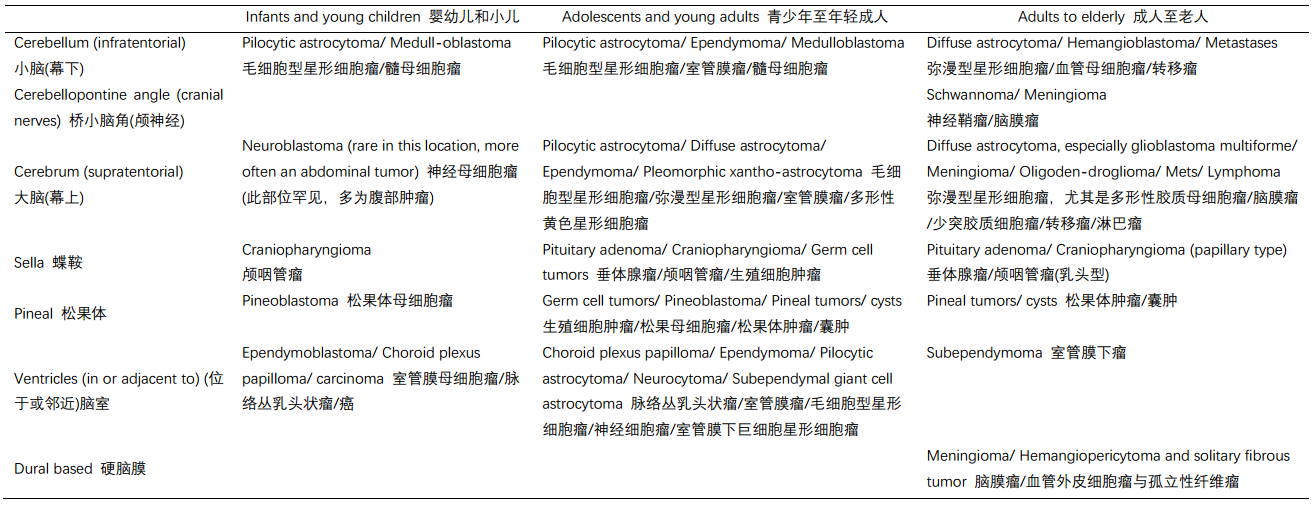
A strategy often proposed is to start by asking if your “lesion” could be normal tissue (i.e., the surgeon has missed). To answer this question you have to know a little normal histology, which is reviewed below. Second, you should ask if your lesion is neoplastic or nonneoplastic. The nonneoplastic lesion that many pathologists worry most about is the demyelinating lesion, which can look like a tumor by radiology. Abundant foamy macrophages, and an absence of obvious tumor cells, should make you think of a possible demyelinating lesion. Gliosis, a reactive proliferation of astrocytes, can also simulate a glioma histologically (see next section). However, once you have decided you have a neoplasm, the real work begins.
一种常用策略:首先提问,你遇到的“病变”有没有可能是正常组织(即,外科医生未取到病变)?回答这个问题,你必须了解一点正常组织学,下面将要复习。其次,病变是肿瘤性还是非肿瘤性?许多病理医生最担心的非肿瘤性病变是脱髓鞘病变,影像学类似肿瘤。丰富的泡沫状巨噬细胞,没有明显的肿瘤细胞,应该让你想到可能是脱髓鞘病变。胶质增生是星形胶质细胞的反应性增殖,镜下也可以貌似胶质瘤(见下一节)。然而,一旦你确定你遇到了肿瘤,真正的工作就开始了。
一般原则一(General Principles I)
First, as in any organ, there are a finite number of cell types in the brain, and each cell type can give rise to a spectrum of neoplasms. In the brain, the cells and their common neoplasms are the following:
首先,正如其他任何器官,大脑中的细胞类型是有限的,每种细胞类型都会产生一个肿瘤谱系。在大脑中,细胞及其常见肿瘤如下:
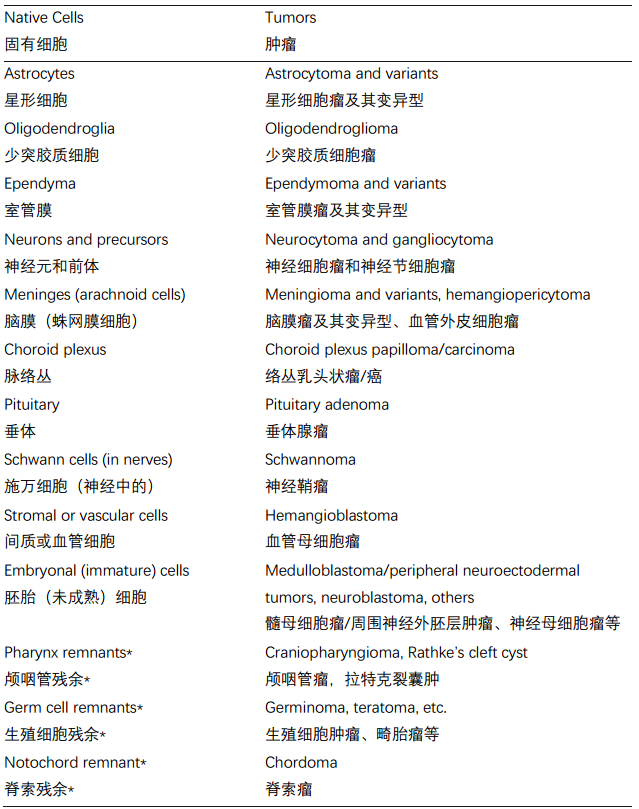
*Remnants are those cell lines that do not anatomically belong in the brain but sometimes get left behind in some developmental fluke. They create midline tumors.
*残余,是那些在解剖学上不属于大脑的细胞系,但有时在某些发育过程中被遗留下来。它们会造成中线肿瘤。
一般原则二(General Principles II)
There is a broad grading system used for most central nervous system (CNS) neoplasms, the World Health Organization (WHO) tumor grade, which ranges from I (most indolent) to IV (most aggressive). In this system, grade I is equivalent to “benign,” but in the CNS something cytologically benign may be clinically devastating depending on where it is growing. For this reason, CNS tumors are not described as benign versus malignant but are graded according to the WHO scale. The grade I and II tumors are sometimes referred to as “low grade,” whereas grade III and IV lesions are considered “high grade.” There is no TNM staging for primary brain tumors; margin status and tumor size are also not usually determined by the pathologist.
大多数中枢神经系统(CNS)肿瘤有一个广泛的分级系统,即世界卫生组织(WHO)肿瘤分级,范围从I级(最惰性)到IV级(最具侵袭性)。在这个系统中,I级相当于“良性”,但在中枢神经系统中,某些细胞学上良性的东西可能在临床上具有破坏性,这取决于它生长的部位。因此,中枢神经系统肿瘤不是描述为良性与恶性,而是根据WHO标准进行分级。I级和II级肿瘤有时称为“低级别”,而III级和IV级病变视为“高级别”;切缘状态和肿瘤大小通常也不是由病理医生决定的。
Many neoplasms are assigned to a grade by definition, but some types have a spectrum of grades based on certain histologic features. For most tumors, the following features are used to assign a higher grade to the lesion:
许多肿瘤根据定义而分级,但某些类型的肿瘤根据某些组织学特征有个分级谱系。对于大多数肿瘤,以下特征使病变分级升高:
Cytologic atypia (a subjective observation requiring some experience)
细胞异型性(需要一些经验的主观观察)
Increasing cellularity relative to lowest grade tumor (again, subjective)
相对于最低级别的肿瘤,细胞数量增多(同样是主观的)
Increasing numbers of mitoses (usually quantitative)
核分裂数增多(通常是定量的)
Microvascular proliferation (objective: either present or absent)
微血管增生(客观:存在或不存在)
Necrosis (objective)
坏死(客观)
These features need to be searched for in every tumor (Table 26.2).
每个肿瘤都要搜索这些特征(表26.2)。
Table 26.2. Morphologic features in increasing order of concern.
表26.2 关注程度渐增的形态学特征

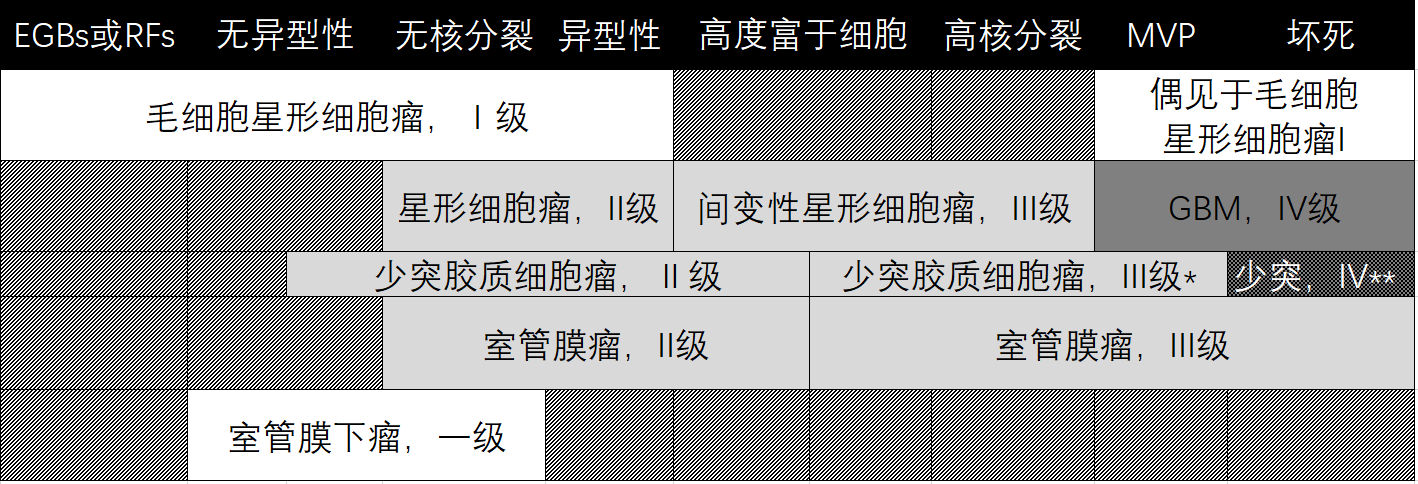
EGBs, eosinophilic granular bodies,嗜酸性颗粒小体; GBM, glioblastoma multiforme,多形性胶质母细胞瘤; MVP, microvascular proliferation,微血管增生; RFs, rosenthal fibers,罗森塔尔纤维。
*Microvascular proliferation is required to diagnose grade III oligodendroglioma,诊断III级少突胶质细胞瘤需要微血管增生。
**Grade IV oligodendroglioma is very unusual and requires extreme malignant features,IV级少突胶质细胞瘤很少见,需要极显著的恶性特征。
一般原则三(General Principles III)
Central nervous system tumors are usually initially sent for frozen section, to guide intraoperative management, and should also be evaluated with a smear or touch preparation, along with the frozen. The smear highlights some features that also narrow your differential diagnosis; on a smear it is easy to detect the fibrillary processes that identify most glial tumors, and nuclear detail is preserved. You can also get a feel for how cohesive (cell-to-cell adhesion) the tumor cells are, from very cohesive tumors (usually metastasis, schwannoma, or meningioma) to very noncohesive tumors (lymphoma, pituitary adenoma, and oligodendroglioma).
中枢神经系统肿瘤通常最初送检做冰冻切片,指导术中处理。做冰冻切片的同时,还应该做涂片或接触印片进行评估。涂片能突出显示有助于缩小鉴别诊断范围的特征;涂片也能很容易检测到有助于识别大多数胶质瘤的纤丝状突起,并能保留细胞核的细节。涂片能让你感受到肿瘤细胞的粘附性(细胞间粘附)程度,从粘附性强的肿瘤(通常是转移瘤、神经鞘瘤或脑膜瘤)到粘附性差的肿瘤(淋巴瘤、垂体腺瘤和少突胶质细胞瘤)。
The general aim of the frozen section diagnosis is to verify that lesional tissue is present, classify the tumor into a major category (such as glioma vs. meningioma vs. carcinoma), and approximate a grade (low or high). It is often difficult and/or unwise to get more specific than this at the time frozen.
冰冻切片诊断的一般目的是验证有无病变组织,将肿瘤分成大类(如胶质瘤、脑膜瘤和癌),并大致分级(低或高级别)。冰冻切片进行更特异性诊断通常是困难的和/或不明智的。
Overall, the tumors discussed in this chapter are organized based on location and age. However, astrocytomas, oligodendrogliomas, and meningiomas are discussed first, as they are so common and can arise almost anywhere along the neural axis. These are mainly tumors of adults. Note that metastases are actually the most common brain tumors in adults but are often diagnosed clinically (no biopsy, no pathologist).
总的来说,本章讨论的肿瘤是根据位置和年龄而编排的。先讨论星形细胞瘤、少突胶质细胞瘤和脑膜瘤,因为很常见,几乎可以出现在沿着神经轴的任何地方。这些主要是成人肿瘤。注意转移瘤实际上是成人最常见的脑肿瘤,但通常是临床诊断(不活检,不需要病理医生)。
星形细胞瘤(Astrocytoma)
Astrocytes, in their nonneoplastic form, are stellate cells with long processes that support the neurons. There are several variants of astrocytoma; the first split in categorization is between diffuse (infiltrating) types and circumscribed variants. Diffuse astrocytomas creep out into the surrounding brain so subtly that it is hard to tell where tumor ends and reactive brain begins. They come in three grades: well differentiated (II), anaplastic (III), and glioblastoma multiforme (IV). The distinction is by the criteria listed earlier. Hypercellularity and mitoses bump the tumor to grade III, while the presence of microvascular proliferation or necrosis is diagnostic of a glioblastoma multiforme.
非肿瘤形式的星形胶质细胞,是具有支持神经元的长突起的星形细胞。星形细胞瘤有几种变异型;首先分成弥漫(浸润)型和局限型。弥漫型星形细胞瘤如此微妙地潜入周围的大脑,以至于很难判断肿瘤的终点和反应性大脑的起点。它们分为三级:高分化(II级)、间变性(III级)和多形性胶质母细胞瘤(IV级)。它们的区别标准见上文。细胞显著增多和核分裂增多使肿瘤归入III级,而微血管增生或坏死是多形性胶质母细胞瘤的诊断特征。
Histologically, the cells of a diffuse astrocytoma are scattered in and among the normal cells of brain, with no visible architecture or cell borders (Figure 26.1). The key is in recognizing (1) that there are too many nuclei, distributed too unevenly, and (2) that many of the nuclei are hyperchromatic, coarse in texture, irregularly shaped, and large. In this sense, the astrocytomas follow the rules of other organs—you just have to learn to recognize the features of a “bad cell.”
组织学上,弥漫型星形细胞瘤的细胞分散在脑的正常细胞里面,看不到结构或细胞边界(图26.1)。关键是要认识到(1)核太多,分布太不均匀,(2)许多核深染,质地粗糙,形状不规则,而且很大。从这个意义上说,星形细胞瘤遵循其他器官的规则,你只需要学会识别“坏细胞”的特征。
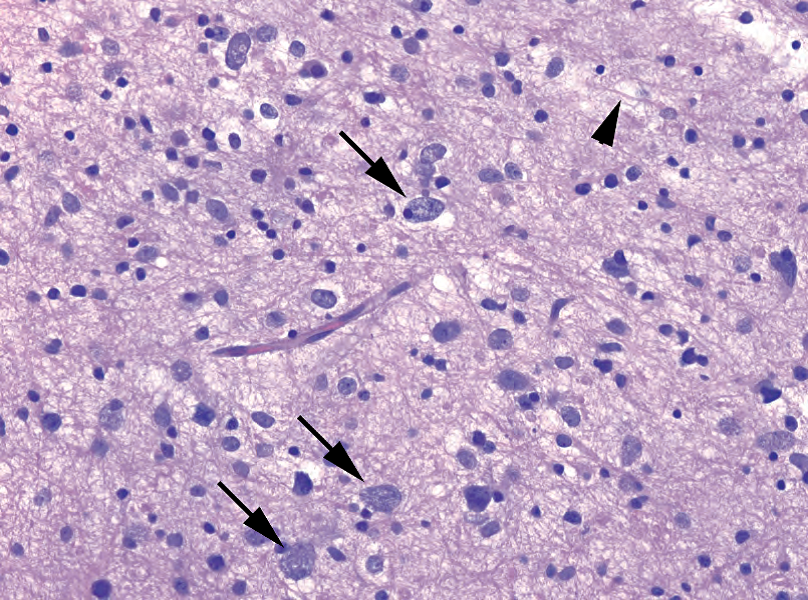
Figure 26.1. Astrocytoma, grade II. This field of tissue is hypercellular relative to normal brain. There are scattered large nuclei with irregular shapes and coarse chromatin (arrows); these are malignant astrocytes. The background is fibrillary (arrowhead), meaning there is a diffuse network of native neuropil and the processes of the malignant astrocytes.
图26.1 星形细胞瘤,II级。与正常大脑相比,这个区域的细胞增多。有散在的大核,形状不规则,染色质粗糙(箭);这些是恶性星形胶质细胞。背景呈纤丝状(箭头),这意味着存在由固有神经纤维和恶性星形胶质细胞的突起共同形成的弥漫网络。
The higher the grade of tumor, the more obvious it becomes. Finding significant numbers of mitoses will generally push you to grade III. The glioblastoma multiforme, while classically shown with pseudopalisading necrosis (tumor cells lining up around a necrotic focus), can be diagnosed just by identifying a combination of malignant astrocytes, focal necrosis not associated with prior therapy, and/or microvascular proliferation, which is a characteristic expanding capillary population (Figure 26.2).
肿瘤分级越高,坏细胞越明显。发现大量的核分裂升为III级。多形性胶质母细胞瘤,虽然典型表现为假栅栏状坏死(肿瘤细胞排列在坏死病灶周围),但只需识别恶性星形胶质细胞、与先前治疗无关的局灶坏死和微血管增生的组合即可诊断。微血管增生是毛细血管群扩张的特征(图26.2)。
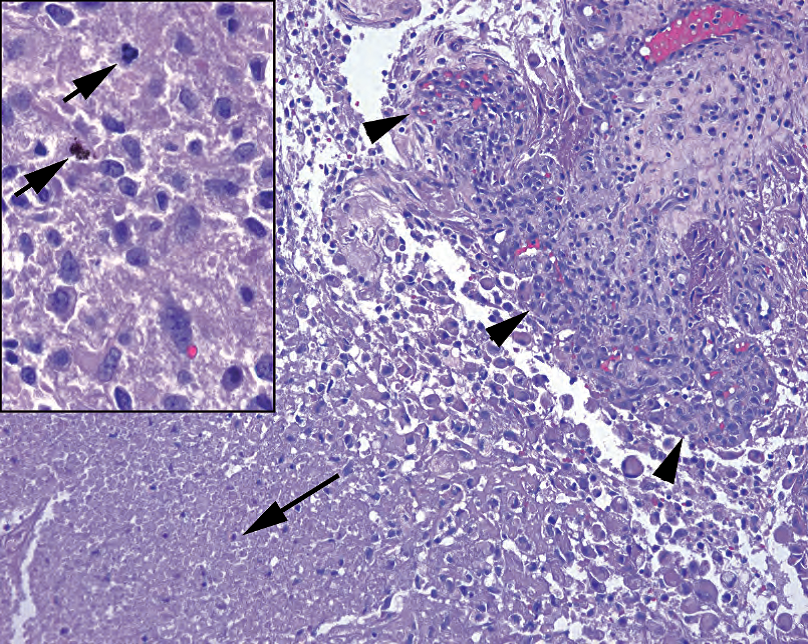
Figure 26.2. Glioblastoma multiforme. In this example, there is both necrosis (arrow) and microvascular proliferation (outlined by arrowheads). The microvascular proliferation is an expanding tangle of capillaries, some of which make glomeruloid forms. Many of the malignant astrocytes in this field have a gemistocytic morphology (eccentric nuclei and abundant pink cytoplasm). Inset: A high-power view of malignant astrocytes with enlarged and irregular nuclei and multiple mitoses (arrows).
图26.2 多形性胶质母细胞瘤。本例兼有坏死(箭)和微血管增生(箭头所示的轮廓)。微血管增生是一种扩张的毛细血管缠结,其中一些呈肾小球样。这个视野的许多恶性星形胶质细胞具有肥胖星形细胞的形态(偏心核和丰富的粉红色细胞质)。插图:恶性星形胶质细胞的高倍观,核增大,不规则,有多个核分裂(箭)。
A circumscribed (nondiffuse) and very indolent form of astrocytoma is the pilocytic astrocytoma (grade I). It occurs in children and young adults and is usually associated with the cerebellum, optic nerve, hypothalamic region, or ventricles. The “pilo” means hair, because the fine processes create a matted-hair–like background (Figure 26.3). These tumors also show the hallmarks of a slow-growing glial process: Rosenthal fibers and eosinophilic granular bodies, both types of pink concretions seen among the tumor cells. Other, more rare, circumscribed astrocytic lesions include the pleomorphic xanthoastrocytoma, a seizure-causing tumor of young adults often found in the cerebral cortex, and the subependymal giant cell astrocytoma of tuberous sclerosis.
毛细胞型星形细胞瘤(I级)是一种局限型(非弥漫型)且非常惰性的星形细胞瘤。它发生于儿童和青年人,通常与小脑、视神经、下丘脑区或脑室有关。“pilo”的意思是头发,因为纤细的突起形成了一种缠结头发样的背景(图26.3)。这些肿瘤也显示出缓慢生长的胶质突起的特征:罗森塔尔(Rosenthal)纤维和嗜酸性颗粒小体,二者都是粉红色,位于肿瘤细胞之间。其他更罕见的局限型星形细胞病变包括多形性黄色瘤型星形细胞瘤(引起癫痫发作的年轻成人肿瘤,常见于大脑皮层)和结节性硬化症的室管膜下巨细胞星形细胞瘤。
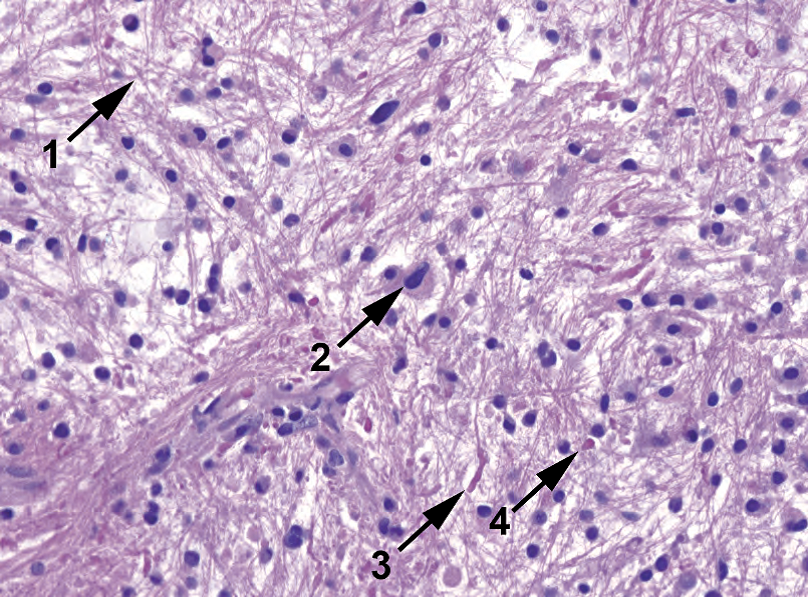
Figure 26.3. Pilocytic astrocytoma. The classic features shown here are a fibrillary or hair-like background (1), scattered large dark nuclei (2), Rosenthal fibers (3), and eosinophilic granular bodies (4).
图26.3 毛细胞型星形细胞瘤。这里显示的典型特征包括:纤丝状或毛发状背景(1)、散在的深染的大核(2)、罗森塔尔纤维(3)和嗜酸性颗粒小体(4)。
Astrocytes can become reactive, in which their processes shorten and become more clearly visible, emphasizing their stellate shape (Figure 26.4). This nonspecific reaction to injury is called gliosis, and it can make nonneoplastic brain appear hypercellular. The key differential is with a well-differentiated astrocytoma, which can also resemble a subtle hypercellularity, especially around the edges. However, although some glioma cells can develop a prominent “gemistocytic” or abundant pink cytoplasm, they usually lack the multiple well-defined processes of reactive astrocytes.
星形胶质细胞可以形成反应性改变,其突起变短,变得更清晰可见,星芒状外形更明显(图26.4)。损伤造成的这种非特异性反应称为胶质增生,它可能导致非肿瘤性大脑显得细胞增多。胶质增生关键的鉴别诊断是高分化星形细胞瘤,后者也可能只是轻微的细胞增多,尤其是边缘。然而,尽管一些胶质瘤细胞可能形成明显的“肥胖星形细胞样”或丰富的粉红色细胞质,但它们通常缺乏反应性星形胶质细胞的多个清楚的突起。
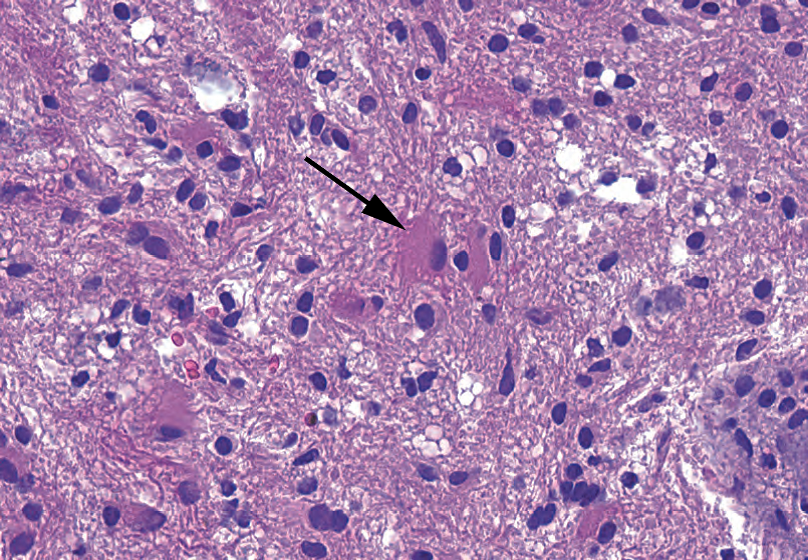
Figure 26.4. Reactive astrocytes. Normal resting astrocytes generally do not have visible cytoplasm. When responding to inflammation or injury, they become compact in shape, with dense pink cytoplasm and stubby processes (arrow).
图26.4 反应性星形胶质细胞。正常静止的星形胶质细胞通常没有可见的细胞质。当对炎症或损伤作出反应时,它们的外形变得紧凑,有致密的粉红色胞质,和粗短的突起(箭)。
Other features that favor glioma over gliosis include the following:
倾向胶质瘤而不是胶质增生的其他特征包括:
Microcystic pattern
微囊模式
Calcifications
钙化
Mitoses
核分裂
Clustering of glial cells around neurons or vessels or below the pia (satellitosis)
胶质细胞成簇聚集在神经元或血管周围,或软脑膜下方(卫星现象)
Irregular distribution and crowding of glial cells
胶质细胞分布不规则、拥挤
少突胶质细胞瘤(Oligodendroglioma)
The oligodendroglioma is typically in the frontal/temporal lobes of adults. Usually it is a grade II tumor, although vascular proliferation and mitotic activity can push it to grade III. Histologically, it is characterized by a population of tumor cells that look like normal oligodendroglia: small round nuclei surrounded by clear halos (a retraction artifact seen only in formalin-fixed tissues). The chromatin is a little clumpy, like a plasma cell, but overall it is uniform (Figure 26.5). Architecturally, they tend to cluster around existing neurons (satellitosis). Other helpful features include a net-like capillary array, a microcystic pattern (as though torn apart by expanding bubbles), and calcifications. On a smear, these cells are not fibrillary like the astrocytoma but instead sheet out as discohesive round cells.
少突胶质细胞瘤通常位于成人的额叶/颞叶。通常为II级肿瘤,可能因血管增生和核分裂活跃而升为III级。组织学上,其特征是肿瘤细胞群看起来像是正常的少突胶质细胞:小圆核,围绕透明空晕(一种收缩假象,仅见于福尔马林固定的组织)。染色质有点粗块状,像浆细胞,但总体上染色质是均匀的(图26.5)。结构上,它们倾向于聚集在现有的神经元周围(卫星现象)。其他有用的特征包括网状毛细血管排列、微囊模式(仿佛被膨胀的气泡撕裂)和钙化。在涂片上,这些细胞不像星形细胞瘤那样的纤丝状,而是成片的不粘附圆形细胞。
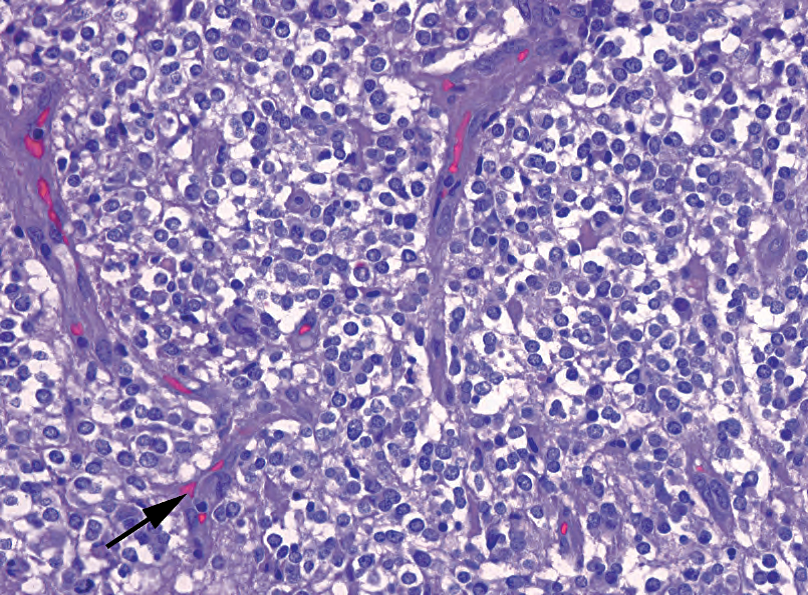
Figure 26.5. Oligodendroglioma. This is a very cellular example of an oligodendroglioma. The closely packed oligodendroglia have very round nuclei which are surrounded by clear halos. The tumor cells are suspended in a network of fine capillaries (arrow).
图26.5 少突胶质细胞瘤。这例少突胶质细胞瘤的细胞非常丰富。密集的少突胶质细胞有非常圆的核,周围有透明空晕。肿瘤细胞悬浮在纤细的毛细血管网(箭)中。
All useful tips, but in reality the oligodendroglioma is evolving from a morphologic diagnosis to a molecular one. “Pure” oligodendrogliomas are almost always characterized by a chromosomal deletion of 1p and/or 19q, and this same population tends to respond well to therapy. As a result, cases with anything other than classic features are often sent for cytogenetics. The idea of a mixed glioma (an oligoastrocytoma) is controversial but is included in the WHO classification.
尽管上述所有的形态学表现有助于诊断,但实际上少突胶质细胞瘤正在从形态学诊断演变为分子诊断。“纯”少突胶质细胞瘤几乎总是以1p和/或19q的染色体缺失为特征,这种肿瘤往往对治疗反应良好。因此,除非具有典型特征,否则通常送检做细胞遗传学检查。混合性胶质瘤(少突-星形细胞瘤)的概念存在争议,但被纳入WHO分类。
脑膜瘤(Meningioma)
The meningioma arises from arachnoid-type cells associated with the dura and is therefore almost always dural based, which may include tumors on the cerebral convexities, tumors of the falx, or tumors around the brain stem or spinal cord. It is common in adults, rare in children. The usual meningioma is a grade I tumor, but certain features or subtypes can raise the grade to II (atypical) or III (malignant).
脑膜瘤起源于与硬脑膜相关的蛛网膜细胞,因此几乎总是基于硬脑膜发生,可能包括脑凸面肿瘤、大脑镰肿瘤,或脑干、脊髓周围的肿瘤。成人常见,儿童少见。普通脑膜瘤为I级,但某些特征或亚型可升级为II级(非典型)或III级(恶性)。
Histologically, meningioma is one of the most protean tumors in the CNS. It has 16 subtypes and counting, very few of which have clinical significance but that must be recognized for their benign selves and not called carcinoma, sarcoma, and so forth. For this reason, before you start trying to learn subtypes, become very comfortable with the basic cytologic features of meningothelial cells—these do not vary much across types. The classic meningothelial cell occurs in a syncytium with its neighbors, so cell borders are invisible. The nuclei are small, oval, and regular, with a very fine powdery chromatin, and they tend to stream in parallel in their syncytial groups (Figure 26.6). Nuclear inclusions may be seen. Meningiomas of all types often have whorls, which are spiral-shaped streams of nuclei, similar to the whorl of a fingerprint. Finally, psammoma bodies are frequently present.
组织学上,脑膜瘤是中枢神经系统中变化多端的肿瘤之一。它有16个亚型,其中很少有临床意义,但必须认识,因为它们本身是良性,不能混淆为癌、肉瘤等。因此,在你开始试图学习亚型之前,先熟悉脑膜上皮细胞的基本细胞学特征,它们在不同类型之间变化不大。经典的脑膜上皮细胞与相邻细胞形成合胞体,因此细胞边界不可见。核小,卵圆形,规则,非常细腻的粉尘状染色质,它们倾向于在合体细胞胞群中像是平行流动(图26.6)。可见核包含体。所有类型的脑膜瘤通常都有旋涡结构,核呈螺旋状排列,类似于指纹的螺。最后,砂粒体常见。
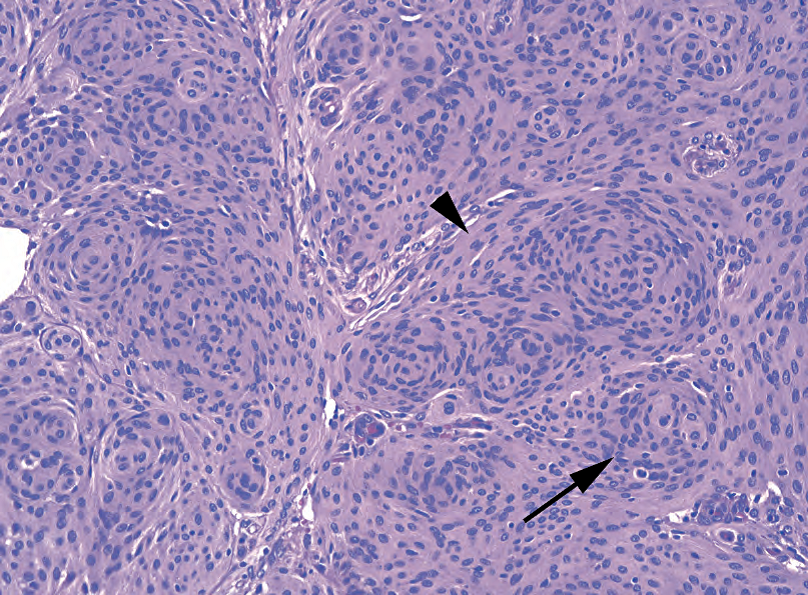
Figure 26.6. Syncytial meningioma. The meningioma nuclei are small and oval and tend to cluster in syncytial groups (arrowhead) without visible cell borders, or make whorls (arrow).
图26.6 合胞体型脑膜瘤。脑膜瘤细胞核小,卵圆形,倾向于聚集成合体细胞群(箭头)或形成旋涡(箭)。看不到细胞边界。
The “classic” meningioma is called the syncytial type, but it can differentiate along more mesenchymal lines (fibrous, angiomatous) or more epithelial lines (secretory, clear cell). Important subtypes are the following:
典型的脑膜瘤称为合胞体型。但也可以更多地沿着间叶细胞系(纤维状、血管瘤样)分化,或更多地沿着上皮细胞系(分泌性、透明细胞)分化。重要的亚型如下:
Clear cell (grade II): glycogen-filled cells, which therefore lose their syncytial appearance, resembling instead a clear cell carcinoma (Figure 26.7)
透明细胞型(II级):充满糖原的细胞,因此失去合胞体外观,类似于透明细胞癌(图26.7)
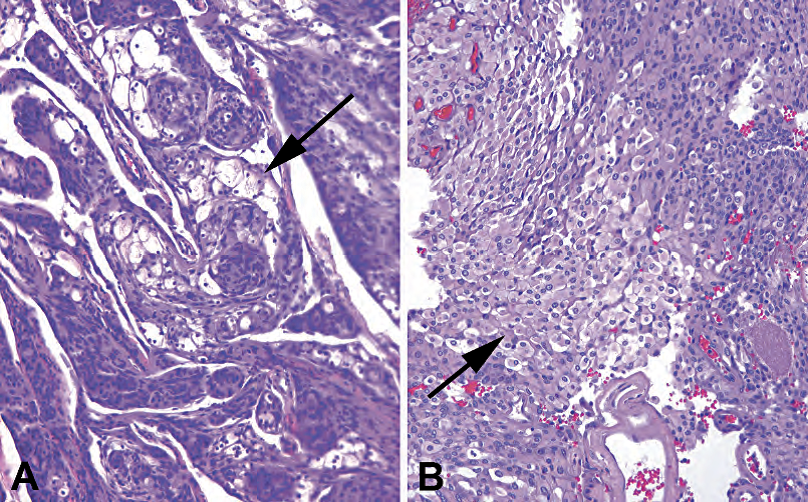
Figure 26.7. Aggressive variants of meningioma. (A) Clusters of distended clear cells (arrow) are visible in this meningioma, indicative of clear cell meningioma. (B) Rhabdoid meningioma has plump eosinophilic cells (arrow) with rhabdoid (resembling immature skeletal muscle) morphology.
图26.7 脑膜瘤的侵袭性变异型。(A)这例脑膜瘤中可见成簇的增大的透明细胞(箭),提示透明细胞脑膜瘤。(B)横纹肌样脑膜瘤有丰满的嗜酸性细胞(箭),呈横纹肌样(类似未成熟骨骼肌)形态。
Chordoid (grade II): resembles a chordoma, with a myxoid background and cords of cells
脊索样型(II级):类似脊索瘤,有黏液样背景和细胞条索
Rhabdoid (grade III): plump pink cells with discrete cell borders, similar to rhabdomyob-lasts (see Figure 26.7)
横纹肌样型(III级):丰满的粉红色细胞,细胞边界清楚,类似横纹肌瘤(见图26.7)
Papillary (grade III): syncytial, meningothelial cells on arborizing fibrovascular cores
乳头状型(III级):合胞体脑膜上皮细胞位于树枝状纤维血管轴心上
A meningioma can also be upgraded based on cytologic criteria, including cellularity, pleomorphism, mitotic rate (over 4 per 10 high-power fields [hpf]), and necrosis. Brain invasion (true infiltration into brain parenchyma) is a poor prognostic sign that previously resulted in the diagnosis of a malignant meningioma. The current WHO classification assigns these tumors a grade II “atypical” designation. Skull invasion, on the other hand, does not affect the tumor grade, although invasion of the skull base can be surgically problematic.
脑膜瘤也可以根据细胞学标准升级,包括细胞增多、多形性、核分裂率(>4/10HPF)和坏死。脑侵犯(真正浸润脑实质内)是一种预后不良的迹象,以前曾被诊断为恶性脑膜瘤。目前WHO把这些肿瘤的归入II级,称为“非典型”。另一方面,颅骨侵犯并不影响肿瘤分级,但颅底侵犯可造成手术麻烦。
Related but much less common lesions are the hemangiopericytoma (HPC) and solitary fibrous tumor. The cell of origin is probably the same, and these are also dural-based, enhancing, well-circumscribed lesions. However, the hemangiopericytoma is the more aggressive tumor of the two. It is a blue and cellular tumor with prominent and stereotypical gaping vessels called staghorn vessels (Figure 26.8). The nuclei are oval but have nucleoli and more coarse chromatin than the meningioma.
与脑膜瘤相关但少见的病变是血管外皮细胞瘤(HPC)和孤立性纤维瘤(SFT)。起源细胞可能是相同的,它们也是基于硬脑膜、影像学增强的、边界清楚的病变。然而,二者之中,HPC侵袭性更强。它是蓝色的细胞丰富的肿瘤,有明显的、特征性开放血管,称为鹿角状血管(图26.8)。核呈椭圆形,但有核仁,染色质比脑膜瘤粗糙。
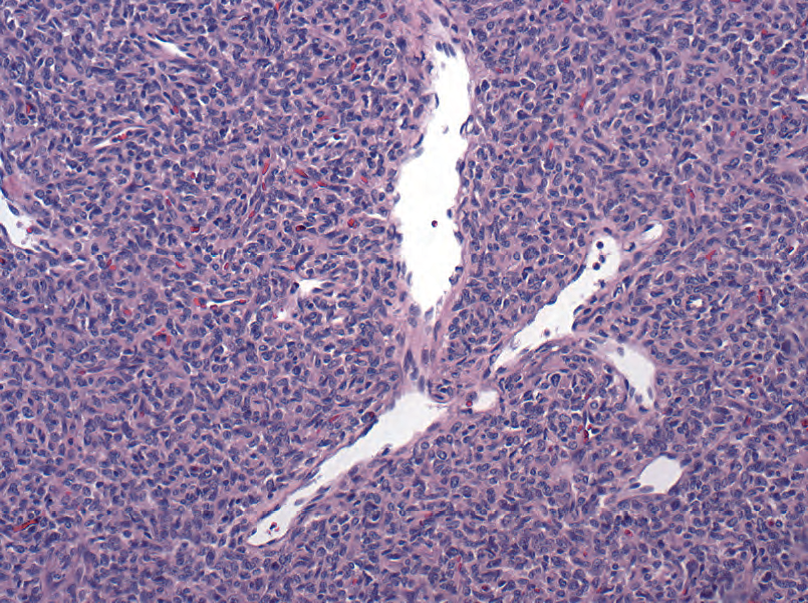
Figure 26.8. Hemangiopericytoma. A typical staghorn vessel in a background of small blue cells that are somewhere between epithelioid and spindled.
图26.8 血管外皮细胞瘤。可见典型的鹿角状血管,背景是小蓝细胞。小蓝细胞介于上皮样细胞和梭形细胞之间。
后颅窝病变(幕下)(Lesions of the Posterior Fossa (Infratentorial))
The main structure of the posterior fossa is the cerebellum. Never forget where you are; the granule cells of the cerebellum look tumor-like on smear if you are not expecting them. Within the cerebellum of adults, your differential usually includes gliomas, metastases, and the hemangioblastoma. Infratentorial tumors are much more commonly seen in children, and in this age group the big players are low-grade gliomas (pilocytic astrocytoma and ependymoma) and medulloblastoma: fortunately difficult to mix up on frozen section.
后颅窝的主要结构是小脑。永远不要忘记你在哪里;如果你不知道这是小脑标本,小脑的颗粒细胞在涂片上看起来像肿瘤。在成人的小脑内,鉴别诊断通常包括胶质瘤、转移瘤和血管母细胞瘤。幕下肿瘤更常见于儿童,主要肿瘤是低级别胶质瘤(毛细胞型星形细胞瘤和室管膜瘤)和髓母细胞瘤:幸运的是,冷冻切片很难混淆。
A special infratentorial location is along the eighth nerve, the most common site of schwannoma in adults. Named the acoustic neuroma because of its position on the auditory nerve, the schwannoma is a tumor of peripheral nerve, made up of the myelinating nonneural Schwann cells.
一个特殊的幕下位置是沿着第八神经,这是成人神经鞘瘤最常见的部位。因为位于听神经上又称为听神经瘤。神经鞘瘤是一种外周神经肿瘤,由有髓鞘的非神经性雪旺细胞组成。
Hemangioblastoma is an uncommon tumor often associated with the von Hippel-Lindau syndrome (VHL). It looks a little like a renal cell carcinoma, with packets of lipidized clear tumor cells surrounded by a delicate capillary network (Figure 26.9). This is unfortunate, because VHL patients also get renal cell carcinoma metastases. Oil Red O (a stain for fat performed only on frozen sections) and some immunostains can sort out the ambiguous cases.
血管母细胞瘤少见,常伴有von Hippel-Lindau综合征(VHL)。它看起来有点像肾细胞癌,精细的毛细血管网包绕着脂质化透明肿瘤细胞(图26.9)。这可能有诊断麻烦,因为VHL患者也会发生肾细胞癌转移。冰冻切片脂肪染色(如,油红O)和一些免疫染色可以区分不明确的病例。
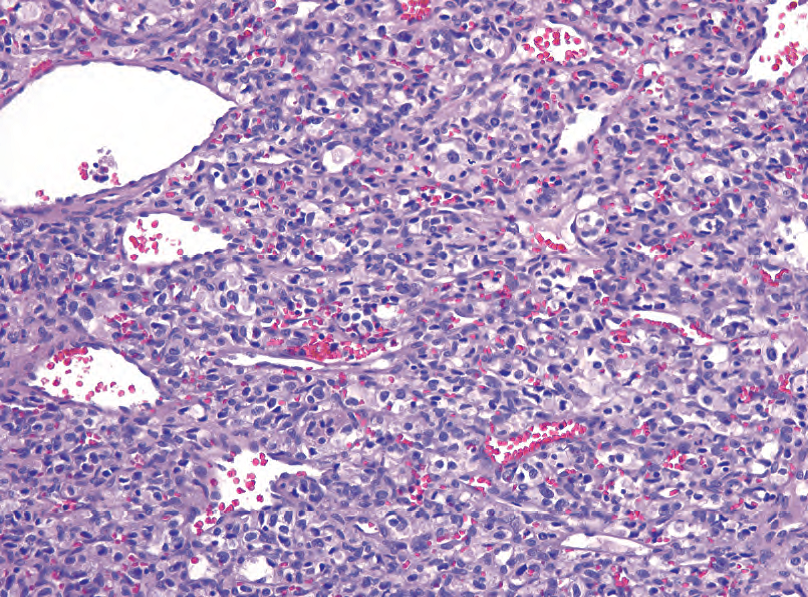
Figure 26.9. Hemangioblastoma. Clear (lipidized) cells with bland nuclei in a background of interlacing and dilated capillaries.
图26.9 血管母细胞瘤。透明(脂质化)细胞,核形态温和,背景中毛细血管交错扩张。
Pilocytic astrocytomas (arising from the fourth ventricle) are described above in the section on astrocytomas. Ependymomas (also from the ventricle) are described below, with other ventricular tumors.
毛细胞型星形细胞瘤(起源于第四脑室)见上文星形细胞瘤一节。室管膜瘤(也来自脑室)与其他脑室肿瘤描述如下。
Schwannoma is a benign fibrillary tumor consisting of a streaming mass of elongated nuclei (Figure 26.10). It often has alternating areas of high and low cellularity (Antoni A and B areas) and tends to make little palisaded arrays called Verocay bodies. Hyalinized (thick, pink) vessels are common. Medulloblastoma is one of the aggressive small round blue cell tumors of childhood (discussed later).
神经鞘瘤是一种良性纤丝状肿瘤,拉长的细胞核平行排列(图26.10)。它通常有富细胞区和少细胞区交替的区域(安东尼A区和B区),倾向于形成称为Verocay小体的小栅栏状排列。透明变性(厚,粉红色)常见。髓母细胞瘤是儿童期侵袭性小圆蓝细胞肿瘤之一(下文讨论)。
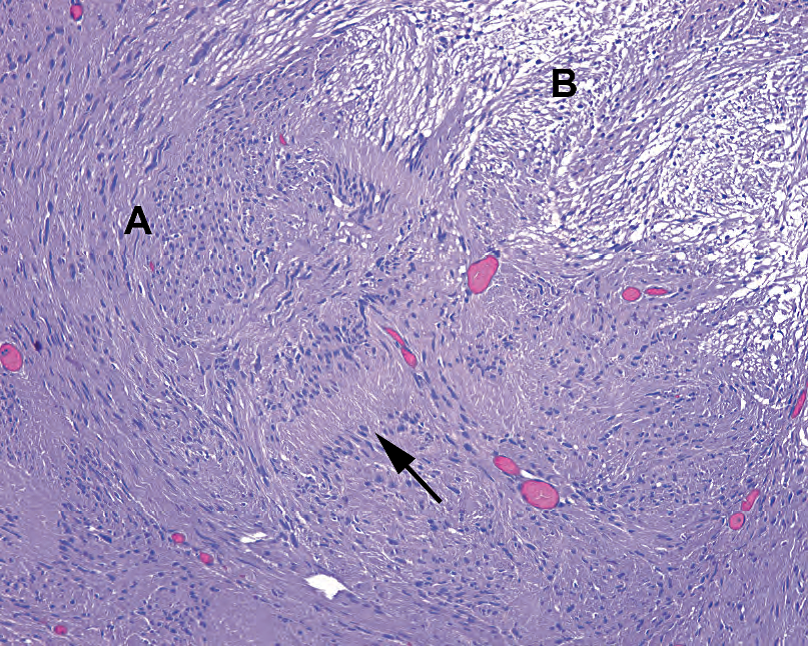
Figure 26.10. Schwannoma. This lesion shows alternating areas of high and low cellularity, called Antoni A (A) and B (B) areas. The elongated Schwann cells tend to stream in parallel groups and form opposing parallel arrays, called Verocay bodies (arrow).
图26.10 神经鞘瘤。富细胞区和少细胞区的交替区域,称为Antoni A区(A)和B区(B)。拉长的雪旺细胞倾向于平行的流水状排列,形成相对的平行阵列,称为Verocay小体(箭)。
中线病变(Lesions of the Midline)
Tumors arising from embryologic remnants tend to occur in the midline. Germ cell tumors include the germinoma, which is essentially a primary CNS seminoma, and the teratoma, more often found in a sacrococcygeal location than in the head. Other germ cell tumors, such as yolk sac tumor and choriocarcinoma, are rare but do occur in the CNS.
胚胎残余引起的肿瘤往往发生在中线。生殖细胞肿瘤包括生殖细胞瘤(本质上是原发性CNS精原细胞瘤)和畸胎瘤(骶尾部比头部更常见)。其他生殖细胞肿瘤虽然罕见,但确实可以发生,如卵黄囊瘤和绒毛膜癌。
Craniopharyngioma and Rathke’s cleft cyst both derive from pharyngeal tissues occurring in the sellar region. The craniopharyngioma, most common in young people, classically has an “adamantinomatous” appearance, meaning it looks like a developing tooth. The nests of cells are bounded by dark palisaded cells, with central areas of stellate cells in a myxoid stroma (Figure 26.11). There is also keratin and debris. Adults, when they get craniopharyngiomas, more often get the papillary type, resembling a nonkeratinizing squamous papilloma.
颅咽管瘤和Rathke裂囊肿均起源于鞍区的咽组织。颅咽管瘤,最常见于年轻人,呈现典型“硬纤维瘤”外观,看起来像一颗正在发育的牙齿。细胞巢被深染的栅栏状排列的细胞围绕,中心区域为星芒状细胞,位于黏液样间质中(图26.11)。还有角蛋白和碎屑。成人颅咽管瘤多为乳头状,类似于非角化性鳞状上皮乳头状瘤。
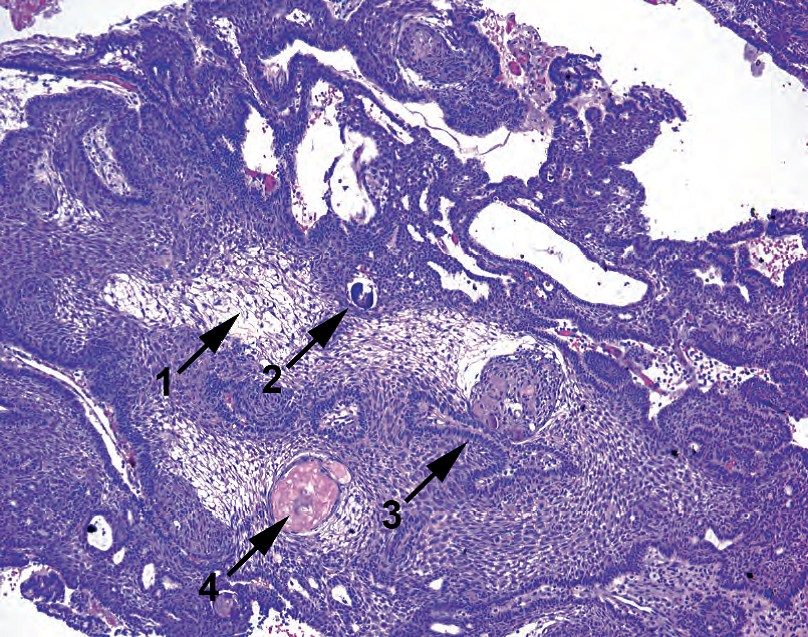
Figure 26.11. Craniopharyngioma, adamantinomatous type. There are areas of stellate reticulum (1), calcification (2), peripheral palisading (3), and accumulated “wet” keratin (4).
图26.11 颅咽管瘤,硬纤维瘤型。有星网层(1)、钙化(2)、周围栅栏状排列(3)和累积的“湿”角蛋白(4)。
Chordomas are tumors of the notochord remnant, hence the name; note that they have nothing to do with “chondroid” or cartilage. They are most often found at the top and bottom of the spine—the clivus and the sacrum. Like intervertebral discs, another notochord remnant, they have a bluish, mucinous background. The “physaliphorous” tumor cells are typically full of clear bubbles and grow in cords.
脊索瘤是脊索残余的肿瘤,因此得名;请注意,它们与“软骨样”或软骨无关(译注,英文脊索和软骨拼写差不多)。最常见于脊柱的顶部和底部,即斜坡和骶骨。和另一种脊索残余物椎间盘一样,它们也有蓝色的黏液背景。“藻盐样”肿瘤细胞通常充满透明的空泡,呈条索状生长。
Other sources of midline tumors include the pituitary and pineal. Pituitary adenoma is a common tumor of the sella. Remember that the pituitary is a very heterogenous mass of cell types, arranged in lobular nests. Therefore, cellular monotony and loss of the normal pattern of small nests of cells is the key to differentiating between an adenoma and normal pituitary (Figure 26.12). The pituitary adenoma looks similar to a neuroendocrine tumor in other sites, both cytologically and architecturally. The pineocytoma is the pineal adenoma. It can be very difficult to tell a pineal tumor from normal pineal, mainly because so few pathologists have actually seen a normal pineal. Tumors that are midline because they are associated with the third or fourth ventricle are discussed in the next section.
中线肿瘤的其他来源包括垂体和松果体。垂体腺瘤是鞍区常见的肿瘤。记住,垂体具有非常异质性的细胞群,排列成分叶状细胞巢。因此,细胞单一和细胞小巢失去正常模式是区分腺瘤和正常垂体的关键(图26.12)。垂体腺瘤在细胞学和结构上与其他部位的神经内分泌肿瘤相似。松果体细胞瘤是松果体的腺瘤。很难区分松果体肿瘤和正常松果体,主要是因为很少有病理医生真的见过正常松果体。位于中线,又与第三或第四脑室相关的肿瘤将在下一节讨论。
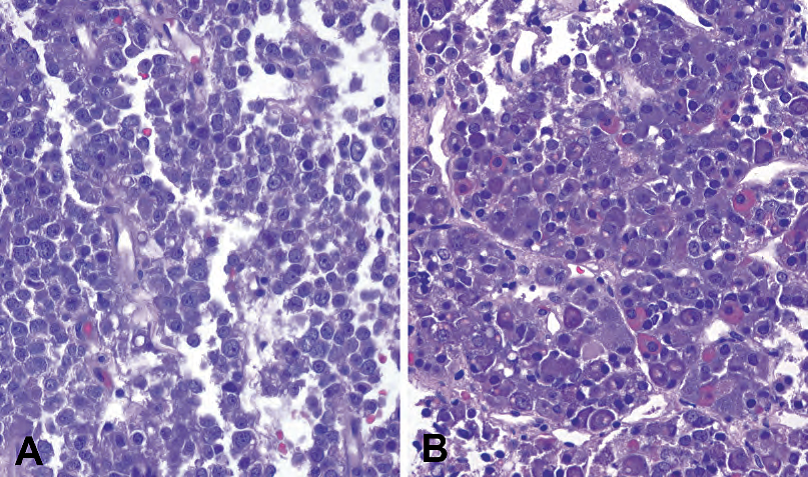
Figure 26.12. Pituitary adenoma versus normal. (A) In a pituitary adenoma, there is a monomorphic population of neuroendocrine-type cells. A collagen or reticulin stain would show sheets of cells no longer encircled by reticulin. (B) Normal pituitary is a mix of many different cell types, both eosinophilic and basophilic, and a reticulin stain would show the tissue divided into small discrete nests.
图26.12 垂体腺瘤与正常对比。(A)在垂体腺瘤中,存在神经内分泌型细胞的单形性细胞群。胶原染色或网状纤维染色会显示成片的细胞,而不是被网状纤维包绕。(B)正常垂体是多种不同细胞类型的混合,包括嗜酸性和嗜碱性细胞,网状纤维染色显示组织被分隔成不相连的小巢。
脑室/脑室周围区域的病变(Lesions of the Ventricular/Periventricular Areas)
室管膜瘤(Ependymoma)
The ependymoma is a usually low-grade (II) lesion of children and young adults. Grade III anaplastic ependymomas also exist, but in most studies this pathologic distinction is not clinically meaningful. It arises from a population of cells that line the ventricles, called ependymal cells. When they become neoplastic, they retain this affinity for making boundaries or lumens and tend to encircle vessels.
室管膜瘤通常是儿童和年轻成人的低级别(II级)病变。III级间变性室管膜瘤也存在,但在大多数研究中,这种病理区别没有临床意义。它起源于被覆脑室的细胞群,称为室管膜细胞。它们变成肿瘤时,保持这种形成边界或管腔的能力,并倾向于包围血管。
Histologically, this is a circumscribed lesion composed of cells with pale oval nuclei that align themselves around blood vessels, sending processes down to the vessel like spokes of a wheel (Figure 26.13). The resulting structure is called a pseudorosette. When the cells make an array around a tiny open lumen, it is called a true rosette. These rosettes are the signature feature of the ependymoma.
组织学上,这是一种局限性病变,核淡染、卵圆形,细胞围绕血管排列,细胞突起伸向血管,就像车轮的辐条一样(图26.13)。这种结构称为假菊形团。细胞围绕一个微小的开放管腔排列时,称为真菊形团。这些菊形团是室管膜瘤的特征。
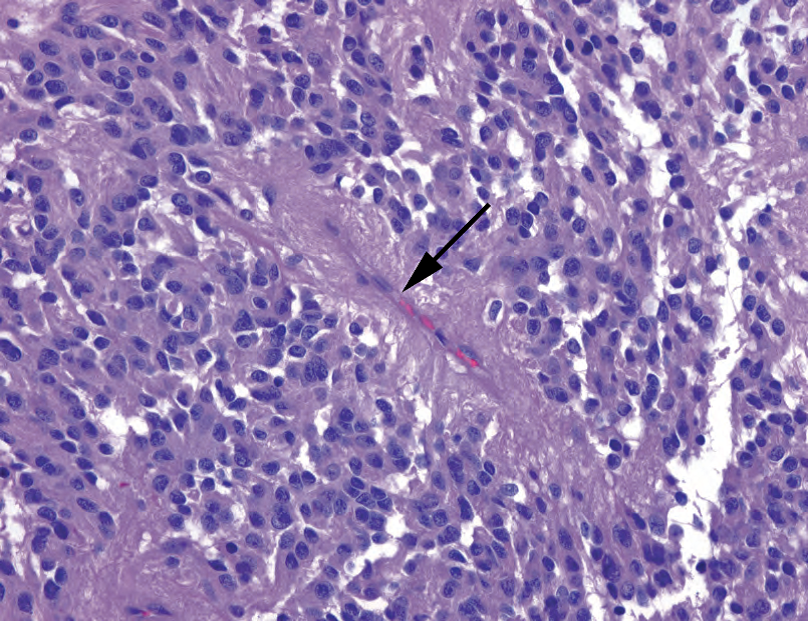
Figure 26.13. Ependymoma. There is a fibrillary background and a tendency for the cells to line up around vessels (arrow), with the ependymal cell processes extending to the vessel and the nuclei around the perimeter. This is actually an example of a pseudorosette; true rosettes have a lumen, not a vessel, at the center.
图26.13 室管膜瘤。有纤丝状背景,细胞倾向于在血管周围排列(箭),室管膜细胞的突起延伸至血管,细胞核围绕在周围。这实际上是假菊形团;真菊形团的中心是管腔,而不是血管。
A special type of ependymoma is the myxopapillary ependymoma, occurring almost exclusively at the filum terminale. It has a myxoid background and ependymal cells radiating off of papillary structures, so it was well named (Figure 26.14). A subependymoma is an even lower grade lesion (I) which typically occurs as a nodule on the ventricular wall.
粘液乳头型室管膜瘤是一种特殊类型的室管膜瘤,几乎只发生在终丝。顾名思义,它有黏液样背景,室管膜细胞从乳头状结构向外辐射(图26.14)。室管膜下瘤是一种级别更低的病变(I级),通常以室壁结节的形式出现。
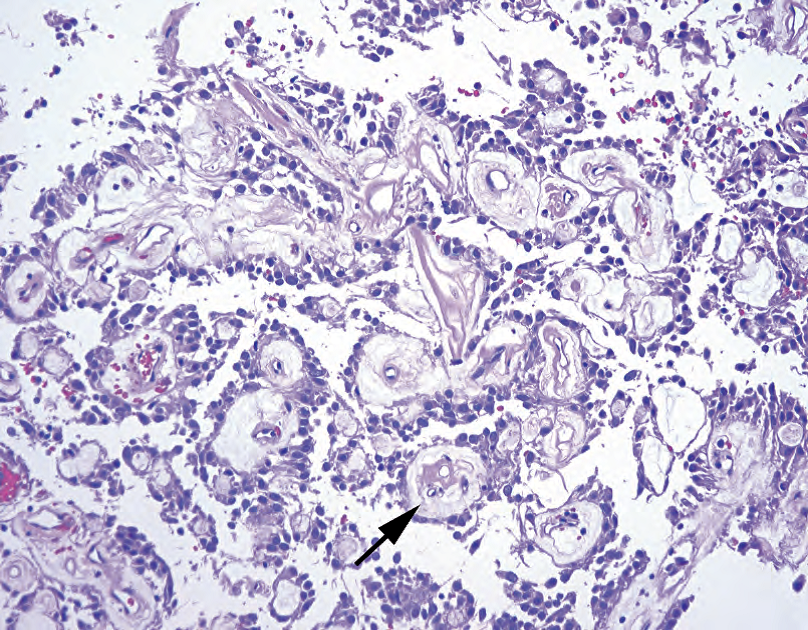
Figure 26.14. Myxopapillary ependymoma. The tumor is a papillary neoplasm with vascular cores surrounded by a myxoid stroma (arrow) and lined by ependymal cells.
图26.14 粘液乳头型室管膜瘤。该肿瘤为乳头状肿瘤,血管轴心被黏液样间质(箭)包围,乳头被覆室管膜细胞。
其他肿瘤(Other Tumors)
Pilocytic astrocytomas are commonly associated with ventricles, especially in children. The subependymal giant cell astrocytoma of tuberous sclerosis is a tumor of the lateral ventricles consisting of very large cells with a somewhat ganglionic appearance.
毛细胞型星形细胞瘤通常与脑室有关,尤其是儿童。结节性硬化症的室管膜下巨细胞星形细胞瘤是一种侧脑室肿瘤,由非常大的细胞组成,有点像神经节样外观。
Central neurocytoma is a low-grade lesion of neural origin, typically occurring in the lateral/ third ventricle area. Like other neuronal tumors, it is uncommon and mainly occurs in children and young adults. It may be mistaken for an ependymoma.
中枢神经细胞瘤是一种神经起源的低级别病变,通常发生在侧脑室/第三脑室区。正如其他神经肿瘤一样,它是罕见的,主要发生在儿童和年轻人。它可能被误认为室管膜瘤。
Choroid plexus papilloma is an intraventricular tumor of young children and can even be congenital. It resembles normal choroid plexus but grows in large arborizing fronds to make a mass. The bland columnar cells form a single-to-pseudostratified layer on the fibrovascular cores. When these tumors become more solid, mitotically active, and invasive, they are known as choroid plexus carcinomas.
脉络丛乳头状瘤是幼儿脑室内肿瘤,甚至可能是先天性的。它类似于正常的脉络丛,但生长在巨大的树枝状突起中,形成肿块。形态温和的柱状细胞在纤维血管轴心上形成单层或假复层排列。当这些肿瘤变得更加实性、核分裂活跃、侵袭性更强时,称为脉络丛癌。
胚胎病变(母细胞瘤)(Embryonal Lesions (Blastomas))
Blastomas are the small blue cell tumors of infancy and childhood, high grade and aggressive. They arise from immature stem cells. A feature they have in common is the tendency to form rosettes, similar to fetal neural tissue. This category does not include hemangioblastoma, or glioblastoma multiforme, or olfactory neuroblastoma (a sinonasal tumor of adults, arising from the olfactory membrane, unrelated to other things called neuroblastoma).
母细胞瘤是婴儿期和儿童期的小蓝细胞肿瘤,高级别,侵袭性强。它们来自未成熟的干细胞。它们的一个共同特征是形成菊形团,类似于胎儿神经组织。胚胎病变(母细胞瘤)这个类别不包括血管母细胞瘤、多形性胶质母细胞瘤或嗅神经母细胞瘤(成人鼻腔肿瘤,起源于嗅膜,与其他称为神经母细胞瘤的肿瘤无关)。
Medulloblastoma is the most common of these tumors. When an identical tumor arises in the CNS outside of the cerebellum, it is called a peripheral neuroectodermal tumor (PNET; note that the PNET/Ewing’s sarcoma tumors described outside the CNS are cytogenetically distinct from the CNS PNET see Chapter 28). These tumors are sheets of small blue cells of high nuclear to cytoplasmic ratio, high mitotic rate, and necrosis (Figure 26.15). The chromatin of the cells is fine and granular like small cell carcinoma, but the nuclei tend to be somewhat wedge or carrot shaped, especially when molded into rosettes. Unlike small cell carcinoma, there is often a fibrillary background due to the neural lineage of this tumor. Like neural stem cells, these tumors retain the ability to differentiate into neurons and glia, so these more differentiated cellular elements may be seen in the tumor.
髓母细胞瘤是这些肿瘤中最常见的肿瘤。这种肿瘤出现在小脑以外的中枢神经系统时,称为周围神经外胚层肿瘤(PNET;注意,中枢神经系统以外描述的PNET/Ewing肉瘤在细胞遗传学上与中枢神经系统PNET不同,见第28章)。这些肿瘤由成片的小蓝细胞组成,具有高核质比、高核分裂活性和坏死(图26.15)。细胞的染色质就像小细胞癌一样的细颗粒状,但细胞核有点像楔形或胡萝卜形,尤其是镶嵌在菊形团上时。与小细胞癌不同,由于该肿瘤为神经细胞系,常有纤丝状背景。正如神经干细胞,这些肿瘤保留了分化为神经元和胶质细胞的能力,因此在肿瘤中可能看到这些分化程度更高的细胞成分。
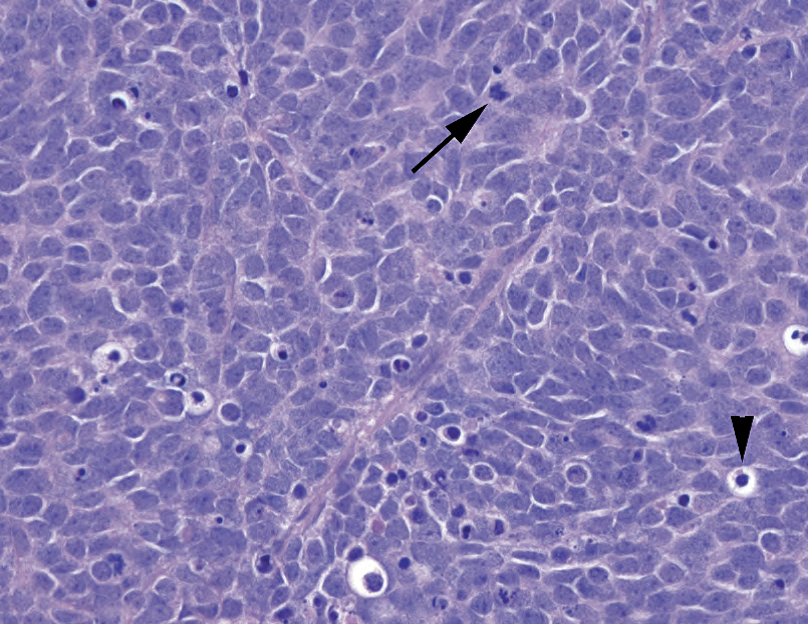
Figure 26.15. Medulloblastoma. A small round blue cell tumor composed of cells that are not actually round but more wedge-shaped or even spindly. The chromatin is very fine in texture, and there are frequent apoptoses (arrowhead) and mitoses (arrow).
图26.15 髓母细胞瘤。小圆蓝细胞肿瘤,实际上不是圆形细胞,而是更像楔形,甚至梭形。染色质非常细腻,常见凋亡(箭头)和核分裂(箭)。
Other tumors in this category, all rare, all grade IV, include ependymoblastoma, medullomyoblastoma, pineoblastoma, retinoblastoma, and neuroblastoma. Neuroblastoma is typically an abdominal neoplasm arising in the adrenal, but it can occur in the CNS as well, whereas retinoblastoma arises in the eye.
这类肿瘤中的其他肿瘤都罕见,都是IV级,包括室管膜母细胞瘤、髓母细胞瘤、松果母细胞瘤、视网膜母细胞瘤和神经母细胞瘤。神经母细胞瘤通常是腹部肿瘤,发生在肾上腺,但CNS也可发生,而视网膜母细胞瘤则发生在眼。
来源:
The Practice of Surgical Pathology:A Beginner’s Guide to the Diagnostic Process
外科病理学实践:诊断过程的初学者指南
Diana Weedman Molavi, MD, PhD
Sinai Hospital, Baltimore, Maryland
ISBN: 978-0-387-74485-8 e-ISBN: 978-0-387-74486-5
Library of Congress Control Number: 2007932936
© 2008 Springer Science+Business Media, LLC
仅供学习交流,不得用于其他任何途径。如有侵权,请联系删除
本站欢迎原创文章投稿,来稿一经采用稿酬从优,投稿邮箱tougao@ipathology.com.cn
相关阅读
 数据加载中
数据加载中
我要评论

热点导读
-

淋巴瘤诊断中CD30检测那些事(五)
强子 华夏病理2022-06-02 -

【以例学病】肺结节状淋巴组织增生
华夏病理 华夏病理2022-05-31 -

这不是演习-一例穿刺活检的艰难诊断路
强子 华夏病理2022-05-26 -

黏液性血性胸水一例技术处理及诊断经验分享
华夏病理 华夏病理2022-05-25 -

中老年女性,怎么突发喘气困难?低度恶性纤维/肌纤维母细胞性肉瘤一例
华夏病理 华夏病理2022-05-07







共0条评论